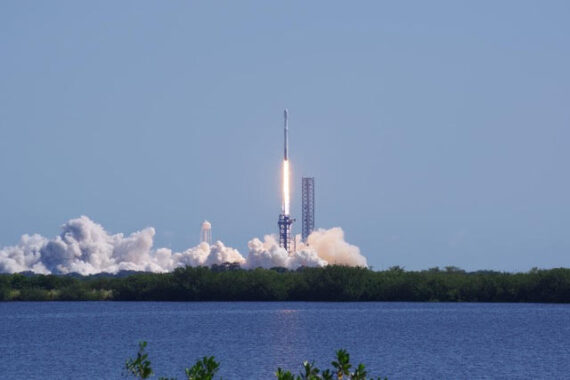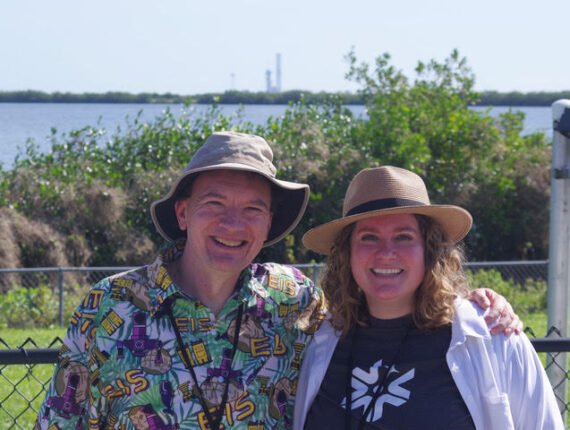On October 14, 2024, the Europa Clipper; the largest interplanetary spacecraft built so far, successfully launched from the Kennedy Space Center. Over the next six years, it will travel to Europa, Jupiter’s fourth-largest moon and the most promising moon for extraterrestrial life. The clipper should arrive in 2030 and immediately begin data collection on Europa to determine whether the moon is habitable for life as we know it. Working for NASA as part of this mission is Wheaton College’s Professor Geoff Collins of the Physics Department. Collins was part of the team that built the craft and in the future, will operate the cameras to take images of Europa’s surface.

A SpaceX Falcon Heavy rocket with Europa Clipper on board takes off from Pad 39A at Kennedy Space Center (photo by Geoff Collins)
The interest in Europa started after the famous Galileo mission to Jupiter and its moons. This expedition discovered that the geology of Europa was bizarre and nothing like Earth’s surface. Europa’s surface was covered in ice, with evidence of a large saltwater ocean beneath the surface possibly up to 100 kilometers deep. For reference, the deepest part of Earth’s oceans is 11 kilometers deep). Scientists were intrigued by Europa and hopeful that its environment could be perfect to support human life.
For Collins, his interest in space dates back to childhood. When asked how he ended up working on this mission Collins said “I have been interested in space ever since I was a little kid, and in particular the Voyager missions launched in the late ‘70s were a huge inspiration to me. I would spend a lot of time staring at these images from space and daydreaming about what it would be like on the strange worlds beyond Mars that Voyager unveiled. I got my big break in college with a summer internship to work on Voyager data from Neptune’s moon Triton, and I’ve been working on exploring the outer solar system ever since.”
Currently, less than 10% of Europa’s surface is imaged at a scale sufficient enough to understand its geology. This one is one of Professor Collins’ main enthusiasms, saying “My main excitement is to see (for the first time) the 90% of Europa’s surface that we only have distant images of. Also, I’m super excited for the first high-resolution pictures of the surface, where we will be able to see chair-sized objects.” Scientists are excited for data collection to begin, because the magnetic field conditions of Europa are consistent with the existence of an ocean under the ice, and there is speculation of possible volcanoes on the bottom of Europa’s seafloor. These potential underwater volcanoes match the hydrothermal vents on Earth’s ocean floor, having some of the highest biological activity of any ecosystem. In other words, this expedition could “rewrite the textbooks,” as Professor Collins says.

Prof. Collins with his former research assistant Emily Martin ’06 at Kennedy Space Center on launch day.
The Europa Clipper mission surely did not happen overnight. The idea started as a rough idea on a napkin 18 years ago, facing continuous funding cuts from NASA over the years. In 2012, the Hubble Space Telescope detected nitrogen and oxygen present in Europa’s atmosphere. That same year, Bill Nye spoke in front of Congress to urge them to fund an exploration of Europa, because of how important the research is for the future of science.
Finally, ten years ago Collins’ team submitted their proposal for the high-resolution camera aboard the spacecraft and received the contract from NASA. With the nominal mission lasting four years, enough data will be collected that scientists will have a much better understanding of Europa and possibly will have data to confirm the question of extraterrestrial life. If you haven’t already gotten the chance to speak with Professor Collins about his work on this mission, definitely reach out to him as there is so much more information on the Clipper and its journey to be told.